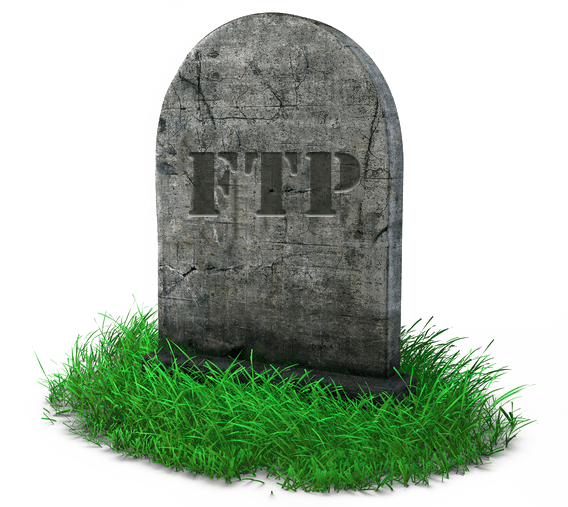At Filecamp we’re all about using the latest technology to make managing your brand assets easier, more secure, and more efficient. In short, sharing files over the Internet should be easy!
The reason why we developed Filecamp is that a lot of the existing platforms for sharing files over the Internet are beginning to show their age. These legacy platforms can no longer keep up with the needs of today’s businesses and design professionals.
In this post we’ll take a look at one of the most well-known legacy platforms for sharing files over the Internet and why it should be relegated to the pages of history. We’re looking at the top 5 reasons why FTP is dead.

1. Not Secure
FTP was not designed to be a secure protocol, it is very vulnerable and there are known exploits. First and foremost, files sent over an FTP connection are not encrypted by default. This is like sending your letters in the mail without envelopes, everyone can read them!
It’s more than the files. When you use FTP, any files you send are transmitted in clear text. This includes any usernames, passwords, and commands you use during the FTP session.
There have been recent attempts to make FTP more secure. However, the most secure method of using FTP, in an SSH tunnel, is often impractical as FTP requires a lot of connections to transmit files.
When it comes to security, there are more recent technologies that encrypt data by default and use more secure transfer protocols. As far as security, FTP is buried 6 feet deep under current technology.
2. Difficult to Access
When it comes to accessing files over FTP, it can be a serious pain in the byte. There are a range of FTP clients across different platforms, some free, some that you have to pay for. With this wide range of clients and server setups, there are often incompatibility issues that prevent you from accessing your files or performing certain commands over the FTP connection, such as deleting or moving folders.
That’s only when you need to access files. When it’s time to give access to your staff, you face another tedious process. You have to login to your control panel for your host and setup a new ftp account. Then, you have to find the best way to get the username and password to your staff, and make sure they don’t forget them. Your staff will also need to setup an FTP client and get the settings for access to your site. That doesn’t even speak to controlling access at a more granular level, giving your staff access to some directories and not to others.
It’s much easier to setup and control access with a more modern platform for sharing files over the Internet. When it comes to ‘A’ for Access, FTP gets an ‘F’ for Fail.
“FTP gets an ‘F’ for Fail”
3. Not Made for Collaboration
Working together over FTP can be a very frustrating experience. First you have to go through the process of getting your staff setup with usernames, passwords, and settings for your server. Then, you have to setup access controls on specific folders.
FTP works by establishing a lot of socket connections while transferring files. We’ve seen how this can make implementing a secure connection difficult. This also makes it difficult to collaborate. FTP wasn’t made for multiple people uploading and downloading files at the same time. Often connections will time out with partial transfers, and you have to delete files and resend them.
Keeping track of files and when they were modified is also a chore. You have to email your staff to let them know you’ve made a change, or they have to compare file sizes and modified dates to know when there’s a new version of a file. You can’t easily preview files, so to look at them for any changes, you have to download each one to check.
Today’s distributed workforce is based on making collaboration easy between team members in different locations. As a relic from an earlier command-and-control style of the Internet, FTP was not made for collaboration.
4. Tough to Connect On The Go
When we dig a little deeper on the technical side, there are often additional configurations that are needed on a network to allow file uploads to FTP. While it’s a bit of a chore to open up the ports at your office, or on your home network when you are working from home, trying to access FTP on the go can be very difficult.
When you use a connection at a café or a hotel while on a business trip, often when you try to connect to an FTP server, you’ll get fateful messages like; “Your connection has timed out…” or “Read timed out …”. This can also happen when you are working at a partner site that has a corporate firewall in place.
Modern online file sharing systems use the web-based HTTP and secure HTTPS protocols, which use exactly the same ports you use to surf the Internet. In nearly all cases, as long as you can access the web, you can access and update your files.
5. It’s Not Easy to Use
It seems like no matter what your server setup or ftp client is, at some point you wind up reading an FAQ or tutorial to make sure your settings are correct. With the wide range of FTP clients and different server setups, it’s impossible to write a guide that covers every possible combination. Sometimes, you have to guess and check to see what works.
FTP clients have improved over the years. However, they still have the feeling of an early version of Microsoft Windows. You’re presented with two windows of directories, local, and remote. Sometimes you’re put at the root of each location and it’s difficult to simply find your ‘Documents’ folder where the files you want to upload are located.
With shared hosting becoming the norm, sorting through the directory structure on the remote server can also be difficult. We know it’s difficult to collaborate, sometimes it’s difficult to simply move things around without making a mistake and damaging your website. With lots of different folder permissions to manage, you can also open security loopholes to your site without knowing it.
ZOMG!: FTP is way behind the times when it comes to security, access, collaboration, and ease of use. Filecamp is part of the next generation of tools for sharing files and collaborating over the Internet and is a professional and modern FTP alternative. We make it safer, easier, and more secure to collaborate with your staff across the country or around the world. Whatever file sharing platform you choose, don’t try to bring FTP back to life, it’s already dead.
Share this Post
